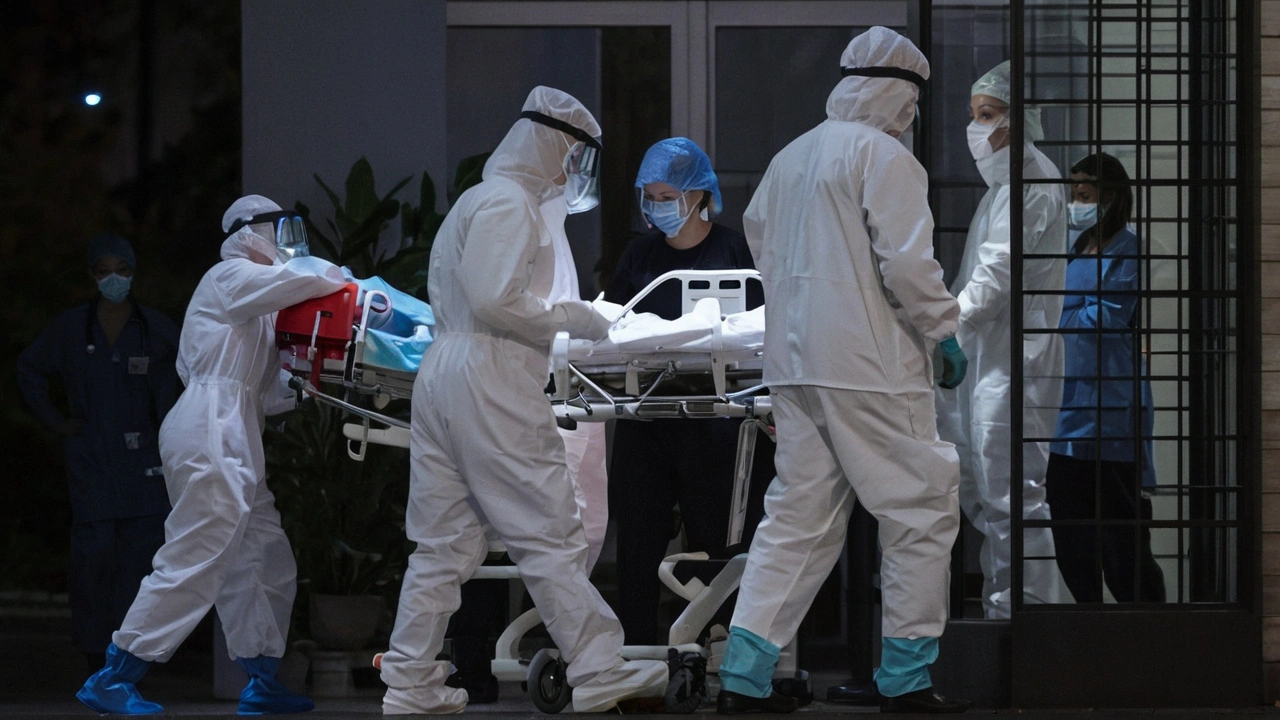Tragedy Strikes in Nagpur
In a distressing turn of events, a 12-year-old boy from Nagpur district in India has succumbed to complications believed to be caused by the H3N2 influenza virus. The boy had been hospitalized with severe respiratory distress, a hallmark symptom of the virus. His untimely death has not only shattered his family but also ignited a wave of concern across the region. Health authorities have swiftly issued an alert and are on high vigilance to prevent any further spread of this potentially deadly virus.
The sudden passing of this young boy has significant implications, given the aggressive nature of the H3N2 virus, which is infamous for causing severe respiratory illnesses. The situation is particularly alarming because children and older adults are the most vulnerable to the complications arising from this virus. The susceptibility of these groups underscores the critical need for immediate and proactive measures to halt its spread.
Immediate Health Screening and Precautionary Measures
Following this heartbreaking incident, health authorities in the Nagpur district have ramped up efforts to contain the virus. Medical teams have begun a thorough screening of the local population, focusing especially on schools and areas where children congregate. This measure aims to identify and isolate any potential cases of the virus as early as possible.
In addition to screenings, schools have been advised to enforce stringent hygiene practices. This includes regular handwashing, using sanitizers, and maintaining an environment of cleanliness. Schools are also being encouraged to educate students and parents about the symptoms of influenza and the importance of vaccination. By raising awareness, authorities hope to curb the spread of the virus and protect the community's most vulnerable members.

The H3N2 Influenza Virus: A Potent Threat
The H3N2 influenza virus is a subtype of the Influenza A virus and is known for its ability to cause serious respiratory infections. It is highly contagious and spreads through droplets when an infected person coughs or sneezes. Symptoms often include fever, cough, sore throat, runny or stuffy nose, muscle or body aches, headaches, and fatigue. For some, especially young children, older adults, and individuals with pre-existing health conditions, the virus can lead to more severe health issues like pneumonia.
In previous years, outbreaks of H3N2 have put significant strain on healthcare systems globally. The 1968 flu pandemic, often referred to as the 'Hong Kong flu,' was caused by an H3N2 virus and resulted in a high number of fatalities worldwide. Although vaccines against H3N2 exist, the virus's tendency to mutate frequently means that new vaccine formulations are required each year to effectively combat it.
A Call for Vigilance and Preventive Action
The death of the young boy in Nagpur serves as a grim reminder of the dangers posed by the H3N2 virus. Health experts are calling for increased vigilance and the adoption of preventive measures. Authorities recommend that people practice good health habits such as frequent handwashing, covering coughs and sneezes, and staying home when feeling unwell.
There's also a strong emphasis on the importance of vaccination. Flu vaccines are available and can significantly reduce the risk of contracting the virus. While the vaccine may not always prevent infection, it can lessen the severity of symptoms and prevent serious complications. Public health campaigns are being intensified to encourage vaccination, especially among children, the elderly, and those with underlying health conditions.

Community Response and Support
The Nagpur community has been profoundly affected by this tragedy, and there's an outpouring of support for the boy's family. Local organizations and community leaders are mobilizing to provide assistance and promote health and safety measures. This includes distributing masks, hand sanitizers, and informational pamphlets about the H3N2 virus.
Community health workers are also playing a crucial role, visiting homes to educate residents about the symptoms of influenza and steps to take if someone might be infected. Their efforts are proving essential in the collective fight against the virus, ensuring that every individual has access to accurate information and the resources needed to stay safe.
Long-Term Strategies for Disease Management
In light of this recent incident, health authorities are not only focusing on immediate containment but also on long-term strategies to manage and prevent the spread of infectious diseases. This includes strengthening surveillance systems to quickly detect and respond to outbreaks, improving public health infrastructure, and investing in research and development for better vaccines and treatments.
Educational programs are being set up to train healthcare professionals and first responders in dealing with similar situations. These programs aim to build a robust and responsive health system capable of managing crises efficiently. By enhancing the overall preparedness, authorities hope to mitigate the impact of future outbreaks and safeguard public health.

Conclusion
The death of the young boy in Nagpur is a stark reminder of the threats posed by viruses like H3N2. It calls for a united response from health authorities, communities, and individuals to combat the spread of the virus and protect those most at risk. Through proactive measures, increased awareness, and robust health strategies, it's possible to prevent such tragedies and ensure a healthier future for all.

jessica zulick
July 23, 2024 AT 00:44My heart goes out to the family, and the tragedy underscores how unforgiving H3N2 can be for kids.
Public health officials are right to roll out school‑based screenings; catching cases early is the most effective way to break chains of transmission.
Vaccination remains the single most powerful tool we have-annual flu shots are updated precisely to match circulating H3N2 strains.
Parents should also reinforce basic hygiene at home: regular handwashing, covering coughs, and keeping sick children isolated until they’re fever‑free for 24 hours.
Community outreach programs that distribute masks and sanitizers can amplify these protective habits, especially in densely populated neighborhoods.
By combining vaccination, vigilant screening, and education, we can hope to prevent another heartbreaking loss.
Partho A.
July 23, 2024 AT 01:46It is imperative that regional health authorities maintain transparent communication channels with schools and caregivers.
Data from the ongoing screening should be compiled daily and disseminated to medical facilities to anticipate any surge in admissions.
Moreover, allocating additional resources to intensive care units will safeguard vulnerable populations should severe cases arise.
Such systematic coordination exemplifies a measured response befitting the seriousness of the situation.
Jason Brown
July 23, 2024 AT 03:26The H3N2 subtype has a well‑documented history of antigenic drift, which necessitates yearly reformulation of the influenza vaccine. In epidemiological terms, the basic reproduction number (R0) for seasonal influenza typically ranges from 1.2 to 1.8, indicating moderate transmissibility. When the virus infiltrates a naïve host, particularly a child, the mucosal immune response may be insufficient to avert lower‑respiratory‑tract involvement. Consequently, secondary bacterial pneumonia often emerges as the principal cause of mortality in such cases. Empirical data from the 1968 Hong Kong flu pandemic reveal that approximately 30 % of recorded deaths occurred among individuals under the age of 20. Modern surveillance systems, however, benefit from rapid polymerase‑chain‑reaction diagnostics that can identify H3N2 RNA within hours of specimen collection. Early detection enables clinicians to administer antiviral agents such as oseltamivir, which have been shown to reduce symptom duration by roughly 1.5 days when supplied promptly. Nevertheless, antiviral resistance remains a plausible concern, underscoring the importance of judicious prescription practices. Public health messaging should therefore emphasize preventive vaccination over reliance on post‑exposure therapeutics. Vaccination campaigns are most effective when they incorporate school‑based outreach, mobile clinics, and culturally tailored educational materials. In addition, robust contact‑tracing protocols can limit superspreader events in densely populated districts. The recent incident in Nagpur should serve as a catalyst for reallocating fiscal resources toward these evidentiary strategies. Allocation of funds to strengthen cold‑chain logistics will preserve vaccine potency from manufacturer to point of administration. Moreover, training local healthcare workers in the interpretation of rapid diagnostic tests will enhance case‑finding accuracy. Finally, fostering community trust through transparent reporting can mitigate misinformation and encourage compliance with health directives. In sum, a multi‑pronged approach that couples vaccination, early antiviral therapy, and systematic surveillance constitutes the most scientifically sound pathway to curtail H3N2 morbidity and mortality.
Heena Shafique
July 23, 2024 AT 04:33Indeed, your exhaustive enumeration reads like a textbook, yet one wonders why such clarity remains elusive to the very officials tasked with implementation.
Patrick Guyver
July 23, 2024 AT 05:40Wow, as if the government hasn't been pulling strings for years-now they want us to trust a "new" flu shot while the real agenda stays hidden.
Don't be surprised if the next wave is engineered to keep us scared and buying more meds.
Stay vigilant, because the quiet ones write the script behind the scenes.
Jill Jaxx
July 23, 2024 AT 06:46Thanks for the heads‑up, staying safe!